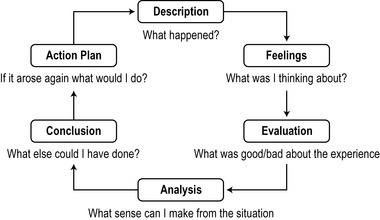14 What have I learnt in a surgical nursing placement?
• To reflect on learning experience in a surgical nursing placement
• To establish what knowledge and skills you have gained during the placement
• To consider how what you have learnt in your surgical nursing placement can be utilised in a range of other placements and in various fields of practice
• To identify the experiences your mentor will use to establish whether you have met your learning goals and/or competences for the placement
Reflection
Timmins (2008:1) offers the following definition of what a portfolio is:
It is beyond the scope of this book to discuss reflection and reflective practice in full, but you will find specific texts and articles, such as Timmins (2008) and Hart (2010), to help you at the end of the chapter.
What then is reflection? Schon (1983) wrote that there are two types of reflection in relation to clinical practice learning: reflection-in-action and reflection-on-action. The latter is the one we focus on in this chapter but it is also important to consider reflection-in-action as well. Consider the definition of reflection offered by Price and Harrington (2010:25):
Critical reflection: evidence based
Miller and Webb (2010:59) refer to this as ‘attending’ to the patient, whereby ‘active listening and attending rely on being able to communicate to the other person that we are listening, understanding, remembering, and even interested in what they are communicating.’
• drawing on a number of similar previous experiences
• examining which one is most similar to the one they are now managing
• possibly considering evidence on new medication
• deciding how to manage the environment they are in
• remembering how they felt the last time they had to undertake a similar situation and telling themselves ‘this time I am going to manage this well … now what do I need … I need to keep talking to him as well, even though he is probably not really hearing me … hang on, I think I can feel a pulse … must mean his heart is now working … best tell Dr Bloggs that it is thready and fast though, and I think missing beats as well … best get the monitor attached … now he is coming round … in order to see what his heart trace is doing …’.
Banning (2008) suggests that a ‘think out loud’ approach may be an excellent way to get student nurses to learn as they problem-solve a case study, just as they would in real life practice.
Models/frameworks to help you reflect on practice learning
A helpful model for reflecting on practice learning (upon which many others are based) is Gibb’s (1988) ‘reflective cycle’ (see Fig. 14.1).
A simpler version of this model for reflection is that by John Driscoll (1994). His framework is based on three stages: What? So what? And now what?
(See http://www.supervisionandcoaching.com/pdf/reflectivelearning.pdf.)
1. What? This is your account or description of the experience or event that took place, making considered judgements on what you think happened and why it happened (description).
2. So what? This is when you consider how you felt and decide if it was a good experience or a bad experience and why. You decide what you think you learnt from the experience or the event (feelings, evaluation and analysis).
3. Now what? This is where you decide what you are going to do in relation to learning from this experience or event. You decide what actions may be necessary, such as: discussing it with someone else; reporting aspects of the experience officially to another person; or developing your knowledge and skills to manage the situation better or differently next time something similar happens (conclusion and action plan).
Stay updated, free articles. Join our Telegram channel

Full access? Get Clinical Tree





